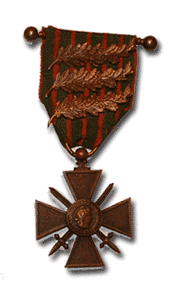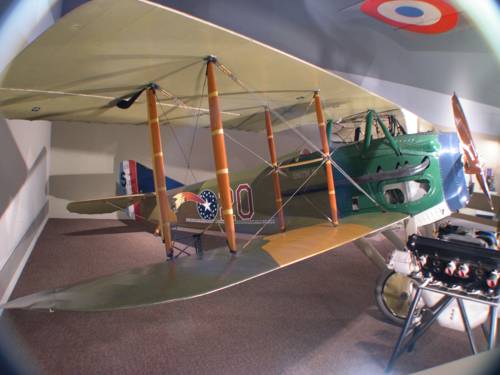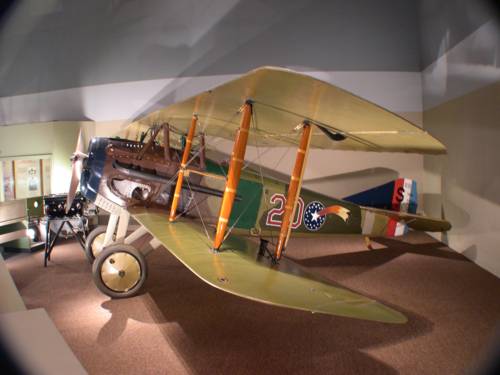United States Air Service
USAS HistorySummary 1917-1918 Lafayette Escadrille
N.124/Spa.124 1st Observation
1st, 12th, 50th, 88th 1st Pursuit Group
27th, 94th, 95th, 147th 1st Bombardment
96th, 11th, 20th 2nd Pursuit Group
13th, 22nd, 49th, 139th 3rd Pursuit Group
28th, 93rd, 103rd, 213th 4th Pursuit Group
17th, 148th, 25th, 141st 5th Pursuit Group
41st, 138th, 638th 3rd Air Park
255th. List of Aces
United States Naval Aviation
US Naval AviationUnited States Marine Corps Aviation
US Marine AviationAircraft
 Nieuport 28
Spad VII
Spad XIII
Fokker Dr.1
Albatros D.Va
Fokker D.VII
Nieuport 28
Spad VII
Spad XIII
Fokker Dr.1
Albatros D.Va
Fokker D.VII
Website: Atlanta SEO
E-mail us

2nd Pursuit Group
The 2nd Pursuit Group had started forming up some time after the 1st Pursuit Group. The squadrons may not have formed up in numeric order, but the Pursuit Groups did. The 2nd Pursuit Group had generally the same organizational structure as the 1st Pursuit Group - four squadrons of fighter planes - all Spad XIIIs. The four squadrons were the 13th aero squadron, 22nd aero squadron, 49th aero squadron and the 139th aero squadron.
Their initial base was Toul Gengoult Aerodrome "a good field with solid buildings that had once been French cavalry barracks" according to ace pilot Raymond Brooks.
"There was one broken-down masonry building we used for protection when the Gothas came over on their night bombing runs from Germany. We would roll out of our bags and run to the building in a part of the airfield that wasn't being used, then watch the bombs exploding and the searchlights from St. Mihiel sweeping the sky. The bombs never killed anyone, but an antiaircraft shell came down through the tile roof of a barracks one night and killed a soldier lying on his bunk. You can't predict anything about war."
Brooks initially joined the 139th squadron, then later captained the 22nd squadron and designed its famous shooting star insignia. He already had one victory with the 139th before joining the 22nd. He got the first kill for the 22nd (a Rumpler) and then got four more before the war ended, for a total of six victories. Brooks was the last surviving American ace. He died in 1991 at the age of 95. His plane, the Smith IV was so named in honor of his fiancee who attended Smith College in Massachusetts.

USAS ace Raymond Brooks' Smith IV Spad XIII at National Air and Space Museum

USAS ace Raymond Brooks' Smith IV Spad XIII at National Air and Space Museum
The 2nd Pursuit Group's planes flew during the bad weather, low clouds, high winds and rain of September 10-12 basically running low level reconnaissance in the face of enemy anti-aircraft fire. American planners, piecing together the data sent back on the various individual missions, were able to determine that the Germans were planning a withdrawal, but had yet to execute it. These missions were run below the clouds at altitudes of 400 down to as low as 50 meters above the ground.
In the bad weather, a 22nd aero squadron pilot named Jacques Swaab mistakenly landed at a German aerodrome, shot up three German planes while he was on the ground, took off and crashed in the Vosges Mountains. He was later rescued.
The unit moved from Toul to Belrain aerodrome during September 20-23.
On September 28, the group knocked eight enemy aircraft out of the sky.
The group did well almost immediately and got into the fray both in the St. Mihiel salient operation as well as the Meuse-Argonne offensive.
On October 4, for instance, over the villages of Dun-sur-Meuse and Landres St. Georges, while escorting the Breguet 14s of the 96th aero squadron after a bombing run, the Breguets were bounced by 30 Fokkers (probably D.VII) and Pfalz fighters. The 2nd Pursuit Group also had 30 planes up in the air - Spad XIIIs, of course. They acquitted themselves well, claiming thirteen victories in exchange for one Spad lost.
On October 9th during another bombing mission, the 2nd Pursuit Group's fighters scored 12 enemy fighters against the loss of one bomber. Numbers such as these are very much contrary to reports of the D.VII being the best fighter of the war.
On October 18th, aircraft of the 2nd and 3rd Pursuit Groups tangled with 30 to 40 enemy aircraft shooting down at least nine.
On October 23rd, the 88th Observation Squadron was tasked to send one Salmson to take photos past German lines to take 40 to 50 photos to document photograph German machine gun and artillery emplacements. The Salmson was to be escorted by two additional Salmson planes from the 88th. - piloted by Lt. Sidney Grant and Lt. Fletcher McCordick They were escorted by five Spad XIIIs - probably from the 2nd Pursuit Group. The aircraft flew past Dun-sur-Meuse when they were pounced upon by seven Fokkers. Three of the Spads peeled off to meet them. From Dun-sur-Meuse, the Salmsons started taking their photos when two more formations of German fighters came to meet the Americans. One formation didn't engage, but the other one consisting of seven zebra-striped Pfalz fighters zoomed in for a fight. The planes were tangling over Aincreville by now. The Americans shot down three of the Pfalz fighters without losing any of their own. However, all of the American fighters were hit repeatedly. And Grant's Salmson was so badly shot up that it later crashed later after crossing back over American lines. Still, Captain Babcock's Salmson made it back safely and, upon landing, the photos that were developed were forwarded to Army Headquarters and used for planning further operations. Lt. Fletcher was recommended for a Distinguished Service Cross. It was an important mission and resulted in quite a success against the odds.
It was probably the first time in the history of American aviation that an American formation had been able to take successful pictures while menaced or attacked by more than twenty planes.
These photos would come in very handy for the attacks that started two days later in the Meuse-Argonne offensive. A mission such as this which allowed intelligence to know where different machine guns and artillery were located may have saved hundreds or even thousands of lives.
Learn more:
1st Observation Group,
1st Pursuit Group,
1st Bombardment Group,
2nd Pursuit Group,
3rd Pursuit Group,
4th Pursuit Group,
5th Pursuit Group and
3rd Air Park.
See the really cool USAS Bases Google Map we've made just for you.
File under:
1st Observation Group - 1st aero squadron, 12th aero squadron, 50th aero squadron
1st Pursuit Group - 27th aero squadron, 94th aero squadron, 95th aero squadron, 147th aero squadron, 185th aero squadron
1st Bombardment Group - 96th aero squadron, 11th aero squadron, 20th aero squadron, 166th aero squadron
2nd Pursuit Group - 13th aero squadron, 22nd aero squadron, 49th aero squadron, 139th aero squadron
3rd Pursuit Group - 28th aero squadron, 93rd aero squadron, 103rd aero squadron, 213th aero squadron
4th Pursuit Group - 17th aero squadron, 25th aero squadron, 148th aero squadron, 141st aero squadron
5th Pursuit Group - 41st Aero Squadron, 138th Aero Squadron, 638th Aero Squadron
3rd Air Park - 255th Aero Squadron
Events/Airshows
 Events/Airshows
Events/Airshows
Pilots/Aviators
 Raoul Lufbery
Raoul LufberyAce of Aces Eddie Rickenbacker
26 victories Quentin Roosevelt
Son of President KIA Frank Luke
18 victories in 17 days Eugene Bullard
1st African Am. Pilot David Ingalls
1st US Navy Ace List of USAS Pilots
Find a Relative American WWI Pilots
Mini bios
USAS Research
 USAS Videos
Reading List
USAS Videos
Reading ListWWI US Aviation Related Links
WWI US Aviation Credits War Wings
by Phillip W. Stewart WWI Maps
Units & Airfields Payne Field
USAS Aerodromes now... USAS Archives
Questions? Need Help? American Expeditionary Forces
WWI Doughboys in France